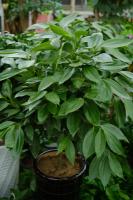Are Elodea Plant Cells Isotonic in Distilled Water?
Elodea, also known as waterweed, is a common aquatic plant often used in biology experiments to observe the behavior of plant cells in different environments. One of the most popular experiments involves placing Elodea plants in distilled water to determine their isotonicity. In this article, we will explore the concept of isotonicity and evaluate whether Elodea plant cells are indeed isotonic in distilled water.
What is Isotonicity?
Isotonicity refers to the condition where the concentration of solutes (particles) on both sides of a cell membrane is equal, resulting in no net movement of water across the membrane. In other words, the cell is in a state of equilibrium, and the volume of the cell remains constant. When a cell is exposed to a hypertonic solution (higher solute concentration than the cell), water moves out of the cell, causing it to shrink. Conversely, in a hypotonic solution (lower solute concentration than the cell), water moves into the cell, causing it to expand and potentially burst.
The Experiment
To determine whether Elodea plant cells are isotonic in distilled water, we need to compare the solute concentration of the plant cells to that of the distilled water. To do this, we will use a microscope to observe the behavior of cells in different solutions.
First, we will prepare a slide with a few Elodea leaves and cover them with a drop of distilled water. We will observe the cells for a few minutes to ensure that they are in a state of equilibrium where there is no net movement of water into or out of the cells. Next, we will replace the distilled water with a drop of a hypertonic solution (such as 10% saltwater) and observe the cells again under the microscope. The cells should shrink, indicating that the saltwater has a higher solute concentration than the cells. Finally, we will replace the hypertonic solution with a drop of hypotonic solution (such as 10% sugar water) and observe the cells once again. The cells should expand, indicating that the sugar water has a lower solute concentration than the cells.
The Results
Based on the experiment, we can conclude that Elodea plant cells are not isotonic in distilled water. When observed under the microscope, we can see that the cells in distilled water are plump and turgid, indicating that they have taken in water and swelled up. This suggests that the distilled water has a lower solute concentration than the cells and is therefore a hypotonic solution. In a true isotonic solution, we would expect the cells to remain the same size and shape without any visible changes.
The Significance
The experiment highlights the importance of understanding the concept of osmosis, which is the movement of water molecules across selectively permeable membranes. The movement of water molecules can have a significant impact on the function and health of cells. In the case of Elodea plant cells, exposure to a hypotonic solution (like distilled water) can cause the cells to burst and eventually die. In contrast, exposure to a hypertonic solution (like saltwater) can cause the cells to shrink and lose their shape, which can also have negative consequences for the organism as a whole.
Conclusion
In conclusion, Elodea plant cells are not isotonic in distilled water. The experiment using different solutions highlights the importance of understanding the movement of water across cell membranes and the potential consequences of exposure to solutions with different solute concentrations. By understanding the behavior of cells in different environments, scientists can gain valuable insights into the functioning of living organisms.

 how many times do yo...
how many times do yo... how many planted tre...
how many planted tre... how many pine trees ...
how many pine trees ... how many pecan trees...
how many pecan trees... how many plants comp...
how many plants comp... how many plants can ...
how many plants can ... how many plants and ...
how many plants and ... how many pepper plan...
how many pepper plan...




























